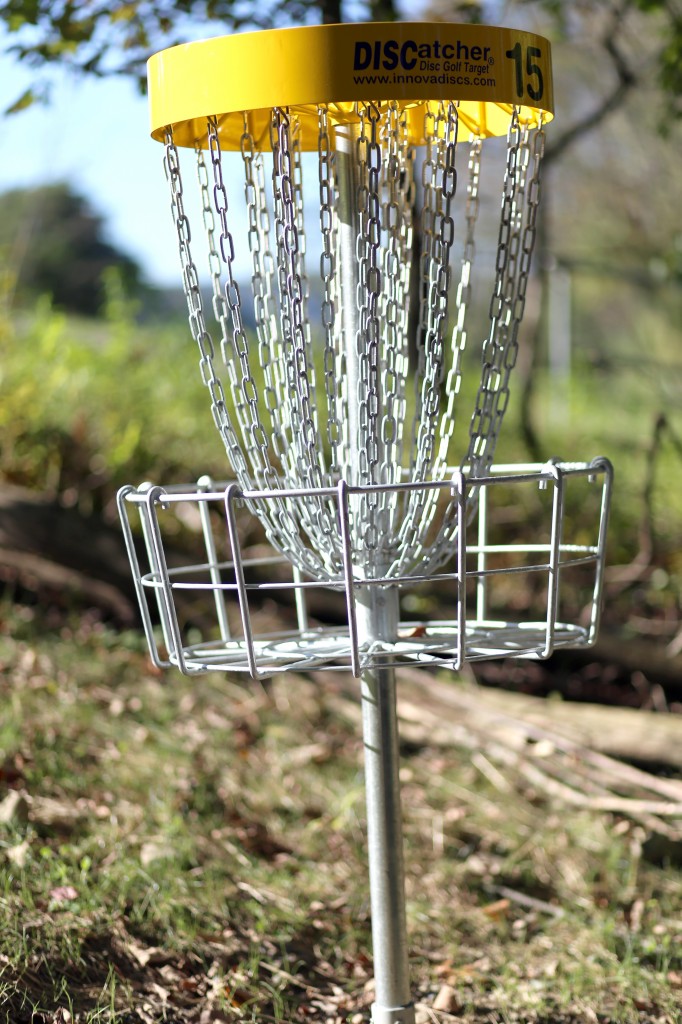
Following two years of discussion and dispute, Campus Recreation has introduced a Disc Golf course to Binghamton University.
The 4,560-foot-long course, which stretches from the path between the East Gym and Old Dickinson Community and runs all the way to East Campus and Lake Lieberman, opened on Aug. 25. The game plays similarly to golf; however, players substitute the ball and club for a disc. The goal is for players to hit a target with as few throws as possible.
According to Cindy Cowden, the associate director of Campus Recreational Services, the proposal for the course was discussed among many offices, including the administration, physical facilities, the Committee for the University Environment (CUE) and the steward of the Nature Preserve.
Because of its relatively inexpensive cost to create and maintain, course plans were finalized in 2011. It was completed in a little over two years, most of that time being devoted to planning and course design.
One of the chief concerns regarding the course was whether it would disturb the ecosystems in the woods. CUE was consulted about the environmental impact of the course before its construction to approve of any changes made to natural areas on campus.
Julian Shepherd, the chair of CUE and an associate professor of biological sciences, went out to the site of the course before it was built in order to locate potentially problematic environmental areas and to ensure the least impact possible.
“We know a lot about where are all the scarce plants and animals are on campus, and we were careful to avoid those kinds of areas,” Shepherd said. “We were certainly wary of them [disc golfers] invading the natural areas, but I think that the encouragement of recreation is great.”
Dylan Horvath, the steward of the Nature Preserve and natural areas on campus, was also brought in to consult Campus Rec about the potential environmental problems with the course, and said that they tried to avoid felling trees.
“We had to cut down some trees to make the fairways, which I’m never happy about, but I compromised,” he said. “But for outdoor recreation on campus, there isn’t a lot of options, and this was kind of a low-impact thing we could do.”
According to Horvath, no scarce trees, like hickory, were harmed, and if plants had to be cleared away, they were mostly invasive species like honeysuckle and multiflora rose.
Horvath also said that he was “wary” of the problems that could be caused by overuse of the course, namely litter that increased traffic to the area could cause. However, in the first few weeks since the Disc Golf course opened, he doesn’t think that garbage in the woods has been a significant problem.
“There’s nothing more than what’s usually out there,” he said. “There are people who think that there’s more garbage than there was, but there really isn’t. I think it’s just more visible than anything else, people are just noticing it more.”
One way that Campus Recreation Services plans to combat any garbage problems in the future is by hiring students in the Federal Work-Study program to monitor the upkeep of the course every week by picking up litter, looking for damage and helping Horvath maintain trails.
Cowden said she hopes students who use the course will respect it and the surrounding area.
“We are very concerned with players being both good stewards of the course and of the natural areas, as well as being good neighbors to the community adjacent to the course,” she said. “We have a beautiful environment on campus and want people to enjoy the space and course.”
The game is open to anyone willing to play. Students interested in playing can sign up at the East Gym with their BU ID.
“It is critical that players and others using the space not only adhere to the rules of play, but act responsibly and conscientiously,” Cowden said. “This includes things like not vandalizing the course equipment or adjacent landscapes, not littering or smoking in the woods, and being respectful of others in the area. Facilities are only as nice as we all work to keep them.”
—Tania Rahman contributed to this report.


